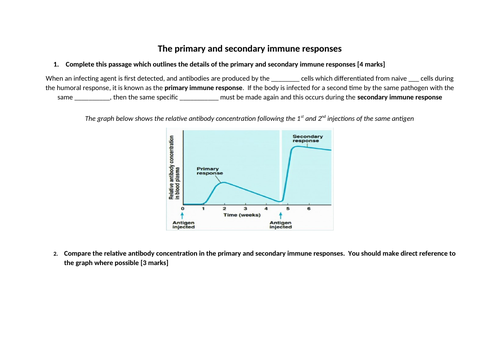



This fully-resourced lesson describes the role of memory cells in the secondary immune response. The PowerPoint and accompanying resources have been designed to cover specification point 6.7 (iv) of the Edexcel A-level Biology B specification but also contains a detailed description of the structure and function of antibodies and therefore covers this part of 6.7 (ii)
As memory B cells differentiate into plasma cells that produce antibodies when a specific antigen is re-encountered, it was decided to link the immune responses and antibodies together in one lesson. The lesson begins by checking on the students incoming knowledge to ensure that they recognise that B cells differentiate into plasma cells and memory cells. This was introduced in a previous lesson on the specific immune response and students must be confident in their understanding if the development of immunity is to be understood. A couple of quick quiz competitions are then used to introduce key terms so that the structure of antibodies in terms of polypeptide chains, variable and constant regions and hinge regions are met. Time is taken to focus on the variable region and to explain how the specificity of this for a particular antigen allows neutralisation and agglutination to take place. The remainder of the lesson focuses on the differences between the primary and secondary immune responses and a series of exam-style questions will enable students to understand that the quicker production of a greater concentration of these antibodies in the secondary response is due to the retention of memory cells.
Get this resource as part of a bundle and save up to 28%
A bundle is a package of resources grouped together to teach a particular topic, or a series of lessons, in one place.
Something went wrong, please try again later.
This resource hasn't been reviewed yet
To ensure quality for our reviews, only customers who have purchased this resource can review it
Report this resourceto let us know if it violates our terms and conditions.
Our customer service team will review your report and will be in touch.